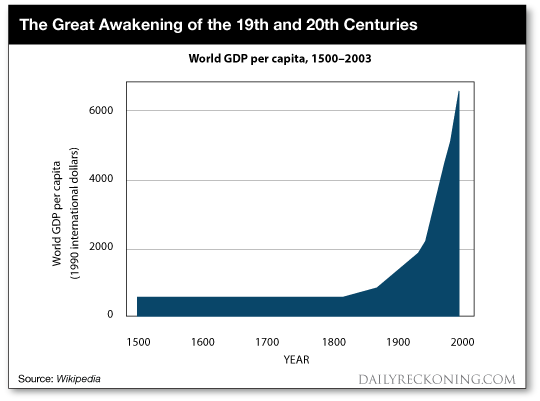The Hard Limits of Progress
Until the 19th century, technological and economic progress advanced inch by agonizing inch.
The fastest transportation in A.D. 1776 was the fastest transportation in 1776 B.C. — the horse.
Maritime commerce flowed to the fickle rhythms of wind and tide, as it had since the opening chapter.
Life was intensely agricultural.
Night was lit by candle and torch… to the extent it was lit at all.
And economic growth?
The Western world’s annual growth rate through 1820 averaged a millimetric 0.06% a year, according to Angus Maddison, economic historian.
That’s 6% a century.
The history of global GDP per capita, 1500–2003:

The chart reveals three centuries of economic dusk.
Then in the mid-to-late-19th century, a light bulb flickered on — literally…
An unlikely series of inventions came along in the mid-to-late-19th century that raised the curtain on a golden age of technological and economic progress… an era of such razzle-dazzle that had no equal in history.
The electric light bulb turned night into day. Electric power brought progress on a thousand fronts.
The railroad, steamship and internal-combustion engine finally put period to the “homely plod of hoof and sail” that paced transportation for millennia.
The telegraph, telephone and radio unhorsed the twin tyrannies of time and distance.
Industry exploded. So did populations. And cities.
The result was a “special century” of technological and economic progress, 1870–1970.
These inventions were so thunderous and so transformative that some argue their impact can never be equaled.
Robert Gordon is an economist at Northwestern University.
Last year he wrote a book called The Rise and Fall of American Growth. From which:
The economic revolution of 1870–1970 was unique in human history, unrepeatable because so many of its achievements could happen only once… the revolutionary century after the Civil War was made possible by a unique clustering, in the late-19th century, of what we will call the “Great Inventions”… What makes the period 1870–1970 so special is that these inventions cannot be repeated.
“With a few notable exceptions,” Gordon adds, “the pace of innovation since 1970 has not been as broad or as deep as that spurred by the inventions of the special century.”
It seems there’s justice in this view.
The light bulb can only be invented once.
It can be improved, refined, brought within sight of the perfections.
But not reinvented. Edison remains on his throne.
And is it coincidence that broader American prosperity began petering around 1970… as the “great inventions” ran their course?
It is by no means the only answer. But perhaps a partial answer.
What truly astounds is the pace of it all.
They crammed more technological progress into that one special century than a previous dozen combined.
Man walked this ball some 40,000 years before he took his fledgling flight above the dunes of Kitty Hawk in 1903.
The 12-second “flight” managed about a dozen feet of altitude… and 120 feet of distance.
Sixty-six years later, man was rocketing to the moon.
Impossible — but there it is.
Has there been progress since 1970?
Only a fool would argue there hasn’t.
But it seems more a progress of the margins… a progress of efficiencies.
They can build a more efficient jet, for example.
But the jet that whisks you across the ocean at 563 mph is no faster than the jet that whisked your father across the ocean at 563 mph in 1958.
It’s true they can make a better, faster car with every whistle and bell.
But cars had air conditioning as early as 1933. They were going over 100 mph by the end of the 1930s.
Progress at the margin.
In no way do we deny the reality of progress.
But we haven’t hatched the equivalent of the internal-combustion engine or the telephone… not to mention electricity.
Venture capitalist Peter Thiel lamented in 2012 that:
Whether we look at transportation, energy, commodity production, food production — that with the exception of computers, we’ve had tremendous slowdown.
Thiel concludes, pithily:
We wanted flying cars. Instead, we got 140 characters.
We can’t help but agree.
It’s a counterfeit progress when someone in Kathmandu can follow the capers of Kim Kardashian on Twitter… but burns the same gasoline that powered a Model T.
But is all this about to change? Are we in for another great technological revolution?
Some argue the world’s perched on the bleeding edge of revolutionary breakthroughs in the fields of robotics, artificial intelligence (AI), computing and other technologies.
They claim the decades ahead will rival — if not excel — the “special century.”
German engineer and economist Klaus Schwab said the coming revolution “will be bigger than anything the world has seen before… It will be a tsunami compared with previous squalls.”
A gust of rhetoric?
Perhaps. Perhaps not.
James Altucher pins his hopes on the technologically based “innovation economy” currently taking shape.
Here is the future, James argues. Here is salvation.
In fact, he argues, “The world will be fixed by the next generation of the economy.”
Time will tell of course… but we hope he’s right.
Lord knows nothing else seems to be working…
Regards,
Brian Maher
Managing Editor, The Daily Reckoning



Comments: